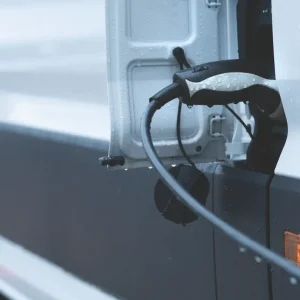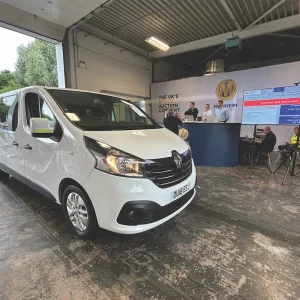Brexit; a Government without an overall majority; warnings of a slowdown in economic growth. Whatever one’s political leanings, most will agree that things in the UK are somewhat less than settled just now, and businesses, small or large, may well be taking a second look at their options, particularly when investing in capital equipment such as vans.
One option for van operators looking to save money could be to buy used vehicles rather than new. Alex Wright, managing director of Shoreham Vehicle Auctions, recently said that expanding SMEs in particular are seeing value in buying a good-quality used van rather than new. Wright said that “as the LCV market is so closely tuned to the current state of the economy, low interest rates, higher inflation and a falling pound would encourage SMEs to switch from new to used in order to better manage their risks”.
Andy Brown, managing director of CD Auction Group, to some degree concurs with Wright: “We are beginning to see some evidence of this. However, the continuing deals being offered by the manufacturers on leasing new vehicles to SMEs via the dealer network means that we don’t see this trend growing too much.”
James Davis, commercial vehicle director at auction firm Manheim, has a different perspective, saying that his firm has seen no evidence of this change: “I would suggest the availability of cheaper-rate finance/manufacturer finance and ownership packages are a major driving factor underpinning retail sales of new and used vans.”
THE CRUNCH
But what about those at the sharp end dealing with SMEs on a day-to-day basis? Barry Clarkson, of used van dealer Clarkson Commercials Ltd of Glasgow, is seeing many customers who have considered new but certain factors have put them off.
“They are quizzical about van leasing, but when it comes to the crunch many still choose to purchase their van – either outright or on finance, mainly due to no mileage limits and no damage chargebacks,” he says. “We are also seeing people who previously have leased but have been faced with massive end-of-lease damage charges – this is helping with the sale of one- to three-year old good-quality, low-mileage vans.”
Gareth Kaye, group van franchise director of new and used dealer group Imperial Commercials, is also seeing a healthy market in late used vans, but at a price: “We are seeing a strong year on used. Wholesale prices of two- to three-year old vans are staying high – they have been for some time now.”
One key theme that emerges from speaking to the experts seems to be that aggressive marketing by both manufacturers and the leasing industry on new vans is having a detrimental effect on the demand, and ultimately value, of very late used stock. “My trade contacts are shying away from late-year stock at auction as the vendors are placing their reserves too close to that of a discounted new or pre-registered van, making it very difficult to purchase vehicles at this age profile at sensible prices,” says Andy Picton, chief commercial vehicle editor at residual value experts Glass’s.
“There is a lot of 15- and 16-plate stock (as well as a growing number of 16/66-plate stock) available on the open market, with a noticeable disconnect between the vendor reserve and what the trade are willing to pay for these vehicles.”
As there is evidence of a connection between new van pricing and the demand for late used vehicles, could this, combined with the potential for an increasing appetite from SMEs for one- to three-year old vans, have a cascading effect on the value of vans in this, and older, higher-mileage sectors?
Picton suggests not: “Whilst volumes in the one- to three-year age bracket remain low, the nicest stock with sensible miles and full service history will always do well. Too much volume with artificially high reserves will only result in most traders concentrating on the more realistically priced/better-value three- to six-year old stock.”
Brown of CD Auction Group agrees: “The market for one- to three-year old vans has been very strong this year to date and we see this continuing as we enter Q3.”
Kaye of Imperial Commercials concurs, saying that “nice vans with the right spec and good miles between two and four years old have always made strong money, so I don’t see that changing anytime soon”.
Duncan Ward, LCV operations director at BCA, also sees no signs of a decline in demand: “There is plenty of competition for small vans aged between three and five years old, and providing they are in clean condition with side loading doors and twin front seats, sellers should expect to achieve near guide values. But damage and high mileage will affect price noticeably.”
However, Steve Botfield, senior editor of commercial vehicles at Cap-HPI, suggests we haven’t seen the last of the effect of vigorous marketing activity from manufacturers and that the effect on used values could be considerable.
“With a decrease in vehicle registrations of circa 6.6% compared to the same period in 2016 (January to May) there will be a number of manufacturers that will not have budgeted for a decrease in sale volumes in the UK, and who will be sitting on a stock of unregistered vehicles.”
Botfield continues: “As history shows, such a situation drives a discounting frenzy on new, and generates a larger than normal number of pre-registered vehicles available on the market. This can currently be seen on advertised discounts on new commercial vehicles. This heavy discounting can only be to the detriment of the one-year-old vehicle, which in turn will cascade down to the older ones.”
LACK OF CHOICE
For anyone venturing into the used market for the first time aiming to save money, what should they be aware of, and what potential pitfalls should they look out for?
Picton suggests that the main difference is a reduced choice when moving from new to a used vehicle: “When purchasing new, you are buying specifically to your operation’s requirements. There are no mileage concerns, no compromise on specification, and you have a full manufacturer warranty to support the vehicle. When buying used, there is always a compromise to be made, whether it’s on the mileage covered, the specification or even the colour.”
Davis from Manheim adds: “New vans have the latest technology (standard and optional) and are viewed as the most fuel-efficient.”
He also makes an important point for those operating in urban areas: “I think the impending roll-out of the ULEZ (Ultra Low Emission Zone) in London and then other cities will mean that used vans that are Euro6 and younger will be in fierce demand as we move through next year into 2019. Any company who runs vans in and around these cities should factor this into their procurement strategy, specifically the alternative applications of petrol and electric vans’.
Cap-HPI’s Botfield also recognises the implications surrounding emissions legislation: “With the introduction of ULEZs, anyone considering future vehicle replacements must take into account where the vehicle will operate, as any diesel vehicle other than a Euro6 will attract an additional fee for driving into London. With limited numbers of Euro6 vehicles hitting the market there will be a demand from the savvy buyer to future-proof their purchase against the ULEZs”
Clarkson adds important points around provenance: “The used van market place is extremely competitive with dealers working on far slimmer margins than most people think so there are bargains to be had. As a dealer, when buying used it’s all down to condition, mileage, paperwork, price. Insist on seeing a full service history, an HPI report… and two keys.”
So, particularly for businesses who wish to own their asset rather than lease, buying used may well be a viable option. Any compromises in specification due to lack of availability of the ‘ideal’ van need to be very carefully considered, and provenance checks should always be carried out on the history and background of the vehicle. Having said that, there appears to be no let-up in the financial incentives being offered to buyers of new vans, which will come with less risk and a full warranty.
And if purchasing second-hand isn’t for you…
Buying a new van with an attractive specification will help to maintain value throughout the van’s working life. Higher-spec vehicles often sell quicker, improving cash flow for the seller.”
Aircon with a bulkhead, digital radio, metallic paint and alloy wheels will attract a lot of attention from trade buyers and end-users alike.
Interior ply-lining is one of the best-value extras for any buyer. It’s expected by buyers and, importantly, it protects valuable company vehicles from ‘inside-out’ damage that is likely to occur day-to-day. The real benefit is that the van is much more likely to be in a more saleable condition after three or four years’ hard work.
Similarly, parking and reversing aids on large vans add value and also help to keep the van in good condition





